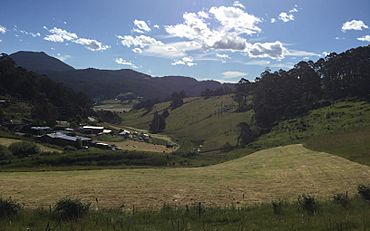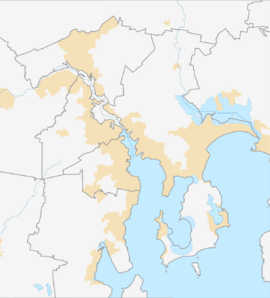Collinsvale, Tasmania facts for kids
Quick facts for kids CollinsvaleHobart, Tasmania |
|||||||||||||||
|---|---|---|---|---|---|---|---|---|---|---|---|---|---|---|---|
 |
|||||||||||||||
| • Density | 31.3/km2 (81/sq mi) | ||||||||||||||
| Established | 1881 | ||||||||||||||
| Postcode(s) | 7012 | ||||||||||||||
| Area | 19.6 km2 (7.6 sq mi) | ||||||||||||||
| Location | 11 km (7 mi) W of Glenorchy | ||||||||||||||
| LGA(s) | City of Glenorchy (75%), Derwent Valley Council (25%) | ||||||||||||||
| Region | South-east, Hobart | ||||||||||||||
| State electorate(s) | |||||||||||||||
| Federal Division(s) |
|
||||||||||||||
|
|||||||||||||||
Collinsvale is a small community located in Tasmania, Australia. It's found about 11 kilometers west of Glenorchy. This area is split between two local government areas: Glenorchy and Derwent Valley. In 2016, about 630 people lived in Collinsvale.
Collinsvale is known for sometimes getting snow, which can be a fun sight!
Contents
Exploring Collinsvale's Past
Collinsvale officially became a recognized locality in 1961. Before that, it was known as Sorell Creek. In the mid-1800s, most of the people living here were British settlers.
When German and Danish Settlers Arrived
In 1870, many new immigrants came to Hobart. A large group of German and Danish people settled in the Sorell Creek area. They were drawn to the cheap land and plenty of clean water.
In 1881, the settlement was officially named Bismarck. This name honored Otto von Bismarck, who was a very important leader in Germany at the time. The name was chosen to show respect for the German settlers.
Even though many German settlers lived there, a Lutheran church was never built in Bismarck. This caused some of the German settlers to join other religious groups. A Lutheran church did open in Hobart in 1871, but the community in Bismarck slowly lost some of its strong German identity.
How Bismarck Became Collinsvale
When the First World War began, there was a strong push to change German-sounding names in Australia. Because of this, Bismarck was renamed Collinsvale. The new name honored David Collins, who was Tasmania's first governor.
However, many people in Bismarck did not want the name to change. They sent a long petition explaining why they wanted to keep the name. They argued that the name Bismarck had helped their area become famous for its excellent farm produce. They worried that changing the name would hurt their reputation and cause bad feelings among neighbors.
They also pointed out that most of them were born in Tasmania and spoke English. They felt the name Bismarck was easy to say and had a good reputation. Despite their efforts, the name was changed. As they feared, Collinsvale never gained the same fame for its produce that Bismarck had.
During this time, Tasmanians of German descent faced difficulties. People sometimes treated them unfairly because of their heritage.
Getting Around Collinsvale
Route C615, which includes Molesworth Road and Glenlusk Road, passes to the north of Collinsvale. From there, Collinsvale Road leads directly into the community.


